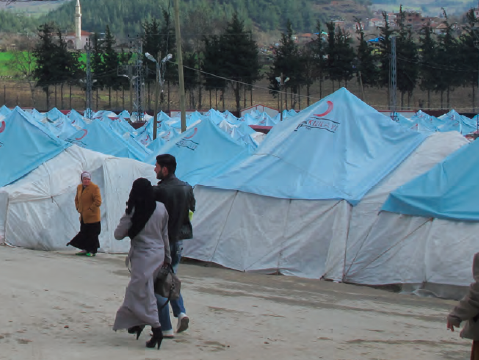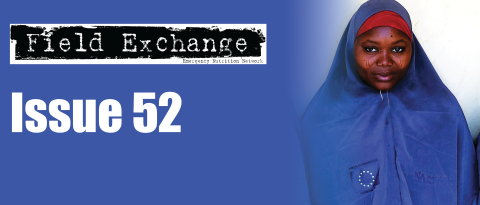Global Nutrition Cluster knowledge management: process, learning & added value
 By Jeremy Shoham, Carmel Dolan and Valerie Gatchell
By Jeremy Shoham, Carmel Dolan and Valerie Gatchell
Jeremy Shoham and Carmel Dolan are ENN Technical Directors. Valerie Gatchell was engaged as an ENN consultant to lead the cluster case study development.
The authors gratefully acknowledge Josephine Ippe, Global Nutrition Cluster Coordinator, for her review and contribution to this article.
The Global Nutrition Cluster’s (GNC) core purpose is to enable country coordination mechanisms to support timely, quality, and appropriate nutrition response to emergencies. A Governance Review of the GNC in June 2013 noted the need for a more formal and systematic system for the identification, compilation and dissemination of learning from country cluster responses. Consequently, knowledge management (KM) was included as a key pillar in the GNC Strategic Plan (2014-2016) and related Work Plan1
As a first step, ENN supported the GNC to document six country learning focused case studies in 2015, which are summarised in this edition of Field Exchange. Five country case studies were shared at the GNC annual meeting in October 2015 and discussions confirmed the value of the process and the importance of continuing to embed KM within the GNC.
Case study development process
After a scoping exercise with the GNC-Coordination Team to identify interested countries and themes, ENN worked with Nutrition Cluster country teams in six countries (Bangladesh, Philippines, Somalia, South Sudan, Yemen, and Ukraine) to document learning around nutrition coordination.
The process in each country was different as it was largely dependent on capacity, as well as the time available in-country for documentation. In some countries, ENN conducted interviews with staff via Skype and then wrote the case study, with reviews and comments by key stakeholders (Yemen, Ukraine). In other countries, Nutrition Cluster Coordinators (NCCs) drafted case studies and worked with their Nutrition Cluster Strategic Advisory Groups to develop the learning, while ENN provided overall editorial support (Bangladesh, Somalia). Other countries developed rough drafts and ENN provided feedback and support during several iterations of document development (South Sudan, Philippines).
The GNC Coordination Team provided significant support for several countries in terms of advocating with cluster staff and country offices for continued commitment and engagement in the process and by commenting on case study drafts.
We have learned through this process that in general, although included as a small part of their job description, there is marginal time for NCCs to reflect, document and capitalise on experiences and learning.
Abridged versions of each case study are presented below.
Overall findings
There are largely two types of Nutrition Cluster identified in this review, those that are Inter-Agency Standing Committee (IASC) mandated and focus on nutrition coordination in response to an emergency (Somalia, South Sudan, Yemen, Ukraine) and those established by the IASC in response to an emergency but now continue as part of government structures (Bangladesh, Philippines).
As a sector, we seem to have a default response in emergencies: treatment of acute malnutrition, infant and young child feeding (IYCF) and a focus on children under 5 years of age. There are questions, therefore, about how the Nutrition Cluster can best support the assessment and targeting of other vulnerable groups and promote an understanding of the need to assess and address other forms of malnutrition in varying contexts. The case studies demonstrated the range of nutrition issues (anaemia, stunting, elderly person’s nutrition needs and non-communicable diseases) which can be present in an emergency but are not often addressed. The GNC needs to consider how to move forward on these challenges technically and programmatically, as well as through advocacy measures.
Integration of severe acute malnutrition (SAM) and moderate acute malnutrition (MAM) treatment programming and reporting is limited; this raises questions about how the GNC can collectively address this issue and support countries to identify the advocacy/influencing routes to a greater continuum of care for the wasted child.
Integration of nutrition across sectors is challenging in all contexts and particularly so in crises. How nutrition can be better represented in other cluster efforts in order to contribute to better nutrition outcomes, through targeting of nutrition sensitive activities such as cash and food transfers and health programming, is a work in progress but hugely valuable. As the role of cash programming in emergencies appears to be rapidly increasing, there is a need for some working guidance from the GNC to support NCCs in ensuring that these programmes maximise nutrition impact.
Engagement in preparedness and longer-term coordination mechanisms is variable and there are questions as to ‘how’ to do this, especially in contexts where a formal IASC activation is not needed or wanted. Furthermore, setting out the pros and cons of where to position the nutrition sub-cluster or when a stand-alone cluster is advised would be helpful.
There have been gaps in coordination capacity in several (not all) countries at national and sub-national levels, resulting in decreased coordination and lack of clarity on the role of the Cluster Lead Agency (UNICEF) in the absence of coordination staff. There appears to be intrinsic difficulties to recruit and retain suitable staff for new emergencies. Gaps ranging from several months up to one year without an active NCC in Level 3 emergencies (the highest classification) were identified as significant constraints. This reflects difficulties around recruitment and gaps in global capacity on nutrition in emergencies (NiE). At the same time, in settings where partner technical capacity is low, NCCs can spend significant time supporting the technical side of programmes (in Bangladesh, the NCC has been heavily involved in trying to roll out community based management of acute malnutrition (CMAM), as well as preparedness activities) at the expense of coordination. Experience from Somalia and South Sudan demonstrates that having significant human resources for nutrition programming and information management allows staff to focus on coordination. There is also a challenge in providing only short-term staffing for coordination in some contexts. For example, in the Philippines, the NCC was also acting as the programme technical specialist for UNICEF but now that the funding for Typhoon Haiyan has ended, the NCC post is no longer present. The challenge here is to maintain residual NiE activities (with a focus on preparedness) in countries like Bangladesh and Philippines where emergencies are recurrent but not ever present.
Priority learning needs
Through discussion of the above points at the 2015 GNC annual meeting, there was agreement to continue to institutionalise learning at the country cluster level. Eleven priority areas for documentation of learning were highlighted, including:
- Situational analysis and response planning when GAM is low
- Assessment and nutrition programming for other populations (adults and pregnancy and lactating women)
- How to effectively link MAM and SAM management
- Nutrition sensitive cash programming
- How to respond to a non-breastfed population - experiences with breast-milk substitutes
- Experiences of integrating nutrition into other sectors (food security; health; and water, sanitation and hygiene)
- Transition planning and process with the Ministry of Health
- Preparedness and systems building
- Impact of coordination on improving emergency response
- How Nutrition Clusters adapt to long-term chronic emergency
- Nutrition in urban areas
In conclusion, through these case studies, the GNC now has a strong body of documentation on a range of coordination challenges, e.g. South Sudan information management; Somalia programme rationalisation in a highly complex and political emergency; and the context challenges to the normal modus operandi of the nutrition cluster, e.g. Bangladesh, Ukraine and Turkey (ENN, 2015), which could be utilised to support guidance or learning tools. The GNC KM work demonstrates the potential value of detailed case studies and the commitment of NCCs and other actors to document their learning.
References
1 GNC Strategic Plan (2014-2016) and related Work Plan available online here
ENN (2015). Coordinating the response to the Syria Crisis: the southern Turkey cross border experience. Field Exchange 48, November 2014. p138.
Related Case Studies:


